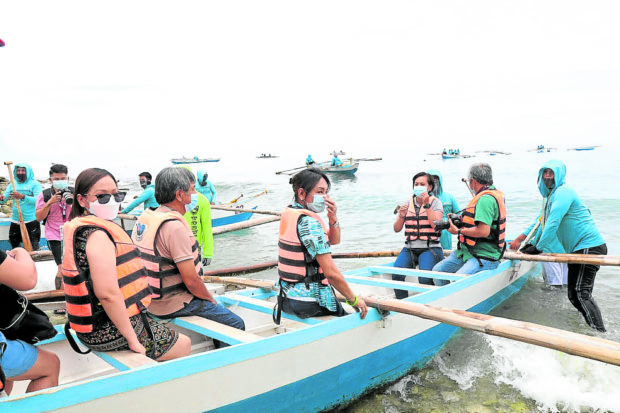Central Visayas loses P35.5B in tourism revenue

WELCOME BACK Whale shark watching in Oslob town in Cebu has resumed as the province reopens its doors to tourists in a bid to revive its economy amid the coronavirus pandemic. —PHOTO FROM CEBU PROVINCE PUBLIC INFORMATION OFFICE
CEBU CITY—Central Visayas has lost $713 million, or about P35.5 billion, in tourism revenue from foreign arrivals due to quarantine restrictions and border closures brought about by the coronavirus disease pandemic.
Efren Carreon, regional director of the National Economic and Development Authority (Neda), said the amount of foregone income from January to June 2020 could have been higher had the agency computed the impact of COVID-19 on domestic tourism.
“One of the largest sectors in Central Visayas is our tourism industry. As we all know, tourism is one of our major economic drivers,” Carreon said in a media interview.
Travel bans
In the first three months of 2020, Central Visayas could have earned $249 million, or roughly P12.5 billion, but this was not realized after strict quarantine measures were imposed in March.
The amount ballooned to $464.8 (P23 billion) in the second quarter after travel bans were expanded to include nearly all destinations abroad, Carreon said.
Among the country’s favorite tourist destinations are found in Central Visayas, such as Cebu and Bohol provinces, and Dumaguete City.
At least 4.3 million foreign tourists visited the region in 2019, an increase of 18 percent from 2018’s 3.6 million, Department of Tourism data showed.
Still on top of the list of foreign visitors in Central Visayas in 2019 are those coming from South Korea with over 1.6 million, followed by China (762,583), Japan (548,627), United States (275,161), Taiwan (135,126), Australia (78,464), United Kingdom (64,860), and Germany (59,786).
In Cebu province, foreign and domestic tourists were allowed back into the island starting August, but they must meet stringent health requirements and register through a centralized online portal created by the Cebu Provincial Tourism Task Force.
In an executive order issued on July 23, Gov. Gwendolyn Garcia required guests to wear province-issued radio frequency identification (RFID) bracelets throughout their stay. The devices contain their email addresses and social media accounts for quick and efficient contact tracing if needed.
The tourists were allowed to engage in such activities as whale shark watching, canyoneering, island hopping, snorkeling, diving, beach events, sightseeing and visits to cultural heritage sites and museums.
The tourism sector has yet to come up with an actual number of tourists who went to Cebu after restrictions were eased.
Jobs, goods, services
Carreon said the four tourism subsectors badly hit by the coronavirus crisis were accommodation, restaurants, shopping and retail, and local transport.
Citing the Neda report, the official said establishments engaged in tourist accommodation lost around $99 million, followed by restaurants ($93 million), shopping and retail ($39 million), and local transport ($17.5 million).
“This amount could have generated a lot of jobs and goods and services. And a lot of people could have benefited with fresh money coming in from our foreign tourists,” Carreon said. INQ
For more news about the novel coronavirus click here.
What you need to know about Coronavirus.
For more information on COVID-19, call the DOH Hotline: (02) 86517800 local 1149/1150.
The Inquirer Foundation supports our healthcare frontliners and is still accepting cash donations to be deposited at Banco de Oro (BDO) current account #007960018860 or donate through PayMaya using this link.